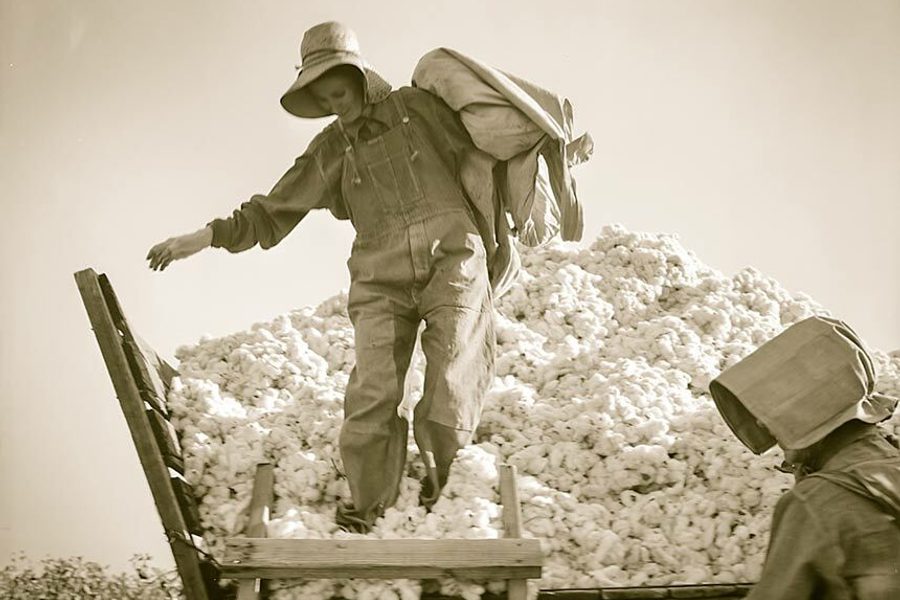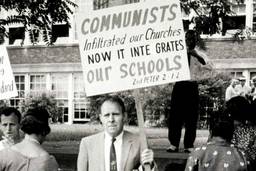How California Birthed the Modern Right Wing
Many of 20th-century conservatism’s tricks were honed in 1930s agribusiness’s fight against farmworkers
Chris Lehmann

Conservative rule in America is by now so deep-seated that a veritable cottage industry has sprung up to explain its origins. By varying accounts, the modern Right’s resurgence has its roots in populist religious revivals, Cold War paranoia, racial scapegoating and the ongoing cultural backlash against the New Left. Taken together, they raise the question: What served as the mainspring force?
Kathryn S. Olmsted, a UC-Davis historian, furnishes an arresting, if partial, answer in Right Out of California: The 1930s and the Big Business Roots of Modern Conservatism. In order to take hold, the American Right had to make the liberal bulwarks of modern American prosperity seem irredeemably creaky, corrupt and sinister. Olmsted focuses on the convergence of the Right’s defining traits — a small-government ideology of economic individualism, a mediagenic narrative of business victimology and a healthy dose of anti-collectivist paranoia — as they were mobilized at the height of the New Deal to battle an enemy that barely registered on the radar of American public opinion at the time: the scattered, multiracial, and grossly undercompensated farmworkers of the Golden State.
How this defining conflict came to pass is itself an instructive story in the limits of New Deal liberalism. Migrant farmworkers, who had seen their wages stagnate well before the Depression, seized upon the Roosevelt administration’s support for collective bargaining to start organizing. But there was just one problem: Thanks to deals cut in Congress with conservative Southern Democrats, farmworkers were exempt from federal collective-bargaining protections (and still are). Nonetheless, desperate Californian agricultural laborers picked up on the robust pro-union mood of New Deal America and took matters into their own hands. As a 1933 wildcat strike among California berry pickers picked up momentum throughout the state’s rich agricultural interior, one Department of Labor bureaucrat wrote to another: “They are union mad, and they have been led to believe that the government upholds them in their stand.”
The group doing much of the leading was the Communist-run Cannery and Agricultural Workers’ Industrial Union (CAWIU). In 1934, the union coordinated a strike for better wages in the cotton fields of the San Joaquin Valley.
The strike defied the feudal ethos of the region’s land barons. California was an early adopter of the agribusiness model of food production, in large part because the desert conditions encroaching on the Central Valley required massive, capital-intensive irrigation projects. The region’s big growers tried to recoup these losses by keeping wages at a bare subsistence level.
When the Roosevelt administration dispatched George Creel, head of California’s National Recovery Administration office, to mediate the strike, growers sensed their oligarchy was in jeopardy. In vigilante run-ins with strikers, grower-led mobs killed two farmworkers and an official with the Mexican consulate trying, like Creel, to broker a compromise. Government officials and liberal reformers rallied to the workers’ cause from around the country, and the growers’ siege mentality took on a xenophobic cast. After Creel issued a report on the baleful working conditions in the valley, an area newspaper — which, like most local institutions, was firmly in the growers’ pockets — wailed: “By all that is fair and just, have American farmers no rights over Communists and aliens?”
Creel’s commission negotiated a compromise rate of 75 cents per hundred pounds of cotton picked — a 25 percent raise — and the chastened growers learned they had to tamp down their more brutal tactics. In 1934, the growers founded “Associated Farmers” (AF), a “citizens committee” against alleged runaway subversion in the region. The group was funded by the state’s largest corporations, but as the Los Angeles Chamber of Commerce explained in a memo, the money behind AF “should be kept a deep, dark secret. This is the only way we can win the fight.”
The first major test of the growers’ revamped strategy came in 1934 with a major strike among workers in the state’s lush Imperial County farmlands. Vigilanteeism continued — but it now tellingly focused on “outside agitators” such a civil rights attorneys coming in to defend strikers in court. “Through the winter and spring, every single one of the five attorneys the ACLU sent to defend Imperial strikers was beaten and threatened with lynching,” Olmstead writes.
In the main, though, the AF and its many civic allies in the Imperial Valley marshaled local opinion behind them via the implausible specter that marginal wage increases for impoverished farmers was the cat’s paw for a coming Communist revolution. The federal mediator for this dispute — a charismatic former World War I army general named Pelham “Happy” Glassford — sympathized at first with the growers, but soon was shocked and virtually radicalized by the cynical PR efforts of AF leaders. (It also scarcely helped matters that a private espionage outfit, known as the “secret thirty,” was spying on Glassford and anyone else deemed a potential threat to growers’ interests.)
“A group of growers have exploited a communist hysteria for advancement of their own interests,” Glassford announced in his blistering report on the conflict. “They have welcomed labor agitation which they could brand as ‘red’ as a means of sustaining supremacy by mob rule, thereby preserving what is so essential to their profit, cheap labor. … They have succeeded in drawing into their conspiracy certain county officials who have become the principal tools of their machine.” In response, growers started lobbing death threats at Glassford, while the Los Angeles Times—the all-but official organ of Golden State business — editorialized, far from coherently, that Glassford’s report showed FDR’s government to be softer on communism than Joseph Stalin himself, since at least, “Communists in Russia are under the iron heel of Stalin and disturbers are sent before a firing squad.”
The Times had no cause to yearn for a purge, as the growers had the next-best Stalinist tactic at their disposal: a show trial. After the strike subsided, cops raided the CAWIU’s offices in Sacramento and brought two dozen union organizers to trial under the state’s absurdly severe Criminal Syndicalism Act, which codified extended prison sentences for anyone found to be advocating the violent overthrow of the government. Itself a relic 1919 of World War I red-baiting, the syndicalism law now gained popular traction thanks to leftward political unrest in California, including the 1934 general strike in San Francisco and the near-election, the same year, of socialist novelist Upton Sinclair to the governorship. (His platform: “End Poverty Now in California” via a guaranteed minimum income and steeply progressive income tax.)
After what was then the longest trial in California history, eight of the defendants were convicted on a lesser charge of conspiracy to commit criminal syndicalism. But the particulars of the case counted for much less than the stirring spectacle of bona fide labor-agitating Communists being led in shackles to serve years-long prison terms. District Attorney Neil McAllister — a “principal tool” of the agribusiness establishment — brought out an actual American flag as a prop during his closing argument and implored the jury to return a conviction “for the good old U.S.A, for My Country ’Tis of Thee, for the Star-Spangled Banner, for my Own United States, and God will bless you.” He crowed at a post-verdict press conference that the outrageous verdict was “a step forward for America and all that America stands for.”
These labor struggles have cast a long shadow on our national politics, particularly when a Californian — who made a point of eating grapes in defiance of the United Farm Workers boycott — launched the conservative revolution proper in the 1980 presidential election. Over and above the notion that “the New Right was [a] neoliberal revolt against the dead hand of government intervention” in the economy, Olmsted argues that:
20th century conservatism was a reaction to the changes in the ways the government was intervening in the economy — in short, a shift from helping big business to creating a level playing field for workers. … [Reagan’s revolution] made the government more responsive to the Americans with the most wealth and power.
Indeed, as a fresh crop of GOP presidential hopefuls trots out phony enemies, foreign and domestic, one can feel the same chill blast of the oligarchs’ fear and hatred. Eight decades after the trial that broke the CAWIU, we’re all still being kept down on the farm.









